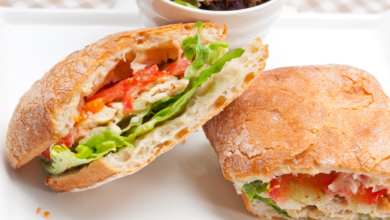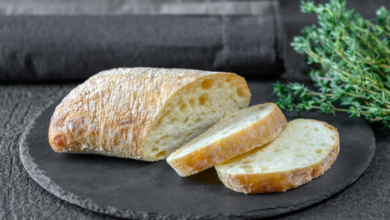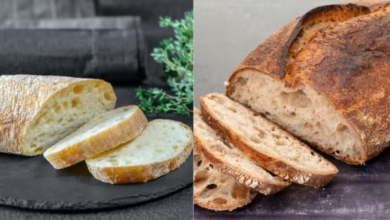Does Ciabatta Have Yeast? We’ll Tell You If It Does!

What To Know
- Commercial yeast is a domesticated yeast that is more reliable and predictable, while sourdough starter is a fermented mixture of flour and water that contains wild yeast and bacteria.
- A long fermentation (12-24 hours) produces a more complex flavor and a chewier crumb, while a short fermentation (2-4 hours) yields a bread with a milder flavor and a more open crumb.
- Bread flour is the best choice for ciabatta bread as it has a high protein content, which gives the bread a strong structure.
Ciabatta bread, with its airy crumb and crispy crust, has captivated bread enthusiasts for decades. But one question that often arises is: does ciabatta bread have yeast? In this comprehensive blog post, we will delve into the world of ciabatta bread and explore its relationship with yeast.
What is Ciabatta Bread?
Ciabatta bread is a beloved Italian bread that originated in the Veneto region in the 1980s. Its unique characteristics include:
- Large, open crumb: The large and irregular air pockets in ciabatta bread give it a light and airy texture.
- Crispy crust: The exterior of ciabatta bread is thin and crispy, providing a satisfying crunch with each bite.
- Mild flavor: Ciabatta bread has a mild and slightly tangy flavor, making it versatile for various pairings.
The Role of Yeast in Ciabatta Bread
Yes, ciabatta bread does have yeast. Yeast is a type of fungus that is used as a leavening agent in bread making. When yeast is added to a dough mixture, it consumes the natural sugars present in the flour. This process produces carbon dioxide gas, which creates the bubbles that form the bread’s crumb.
Types of Yeast Used in Ciabatta Bread
Traditionally, ciabatta bread is made using a natural sourdough starter. A sourdough starter is a fermented mixture of flour and water that contains wild yeast and bacteria. However, commercial bakeries often use commercial yeast, which is a type of domesticated yeast that is more reliable and predictable.
The Impact of Yeast on Ciabatta Bread
The type of yeast used and the fermentation process have a significant impact on the flavor, texture, and shelf life of ciabatta bread.
- Sourdough starter: Bread made with sourdough starter has a more complex and tangy flavor, a denser crumb, and a longer shelf life.
- Commercial yeast: Bread made with commercial yeast has a milder flavor, a more open crumb, and a shorter shelf life.
The Fermentation Process
The fermentation process is crucial for the development of ciabatta bread‘s unique characteristics. The length and temperature of the fermentation period affect the bread’s flavor, texture, and aroma.
- Long fermentation: A long fermentation period (12-24 hours) allows the yeast to fully develop, resulting in a more complex flavor and a chewier crumb.
- Short fermentation: A short fermentation period (2-4 hours) produces a bread with a milder flavor and a more open crumb.
Other Factors Affecting Yeast Activity in Ciabatta Bread
In addition to the type of yeast and the fermentation process, other factors can also influence yeast activity in ciabatta bread, including:
- Flour: The type of flour used can affect the yeast’s ability to consume sugars and produce gas.
- Water: The amount and temperature of water in the dough can impact yeast growth and activity.
- Salt: Salt can inhibit yeast activity, so it is important to add it at the right time during the bread-making process.
Conclusion: The Essence of Ciabatta Bread
Ciabatta bread’s unique characteristics are a testament to the delicate balance between yeast, fermentation, and other factors. Whether you prefer the tangy complexity of sourdough or the mild simplicity of commercial yeast, understanding the role of yeast in ciabatta bread will enhance your appreciation for this culinary masterpiece.
FAQ
Q: Can I make ciabatta bread without yeast?
A: No, yeast is essential for the leavening process in ciabatta bread.
Q: What is the difference between commercial yeast and sourdough starter?
A: Commercial yeast is a domesticated yeast that is more reliable and predictable, while sourdough starter is a fermented mixture of flour and water that contains wild yeast and bacteria.
Q: How long should I ferment ciabatta bread for?
A: The ideal fermentation time depends on the desired flavor and texture. A long fermentation (12-24 hours) produces a more complex flavor and a chewier crumb, while a short fermentation (2-4 hours) yields a bread with a milder flavor and a more open crumb.
Q: What is the best flour to use for ciabatta bread?
A: Bread flour is the best choice for ciabatta bread as it has a high protein content, which gives the bread a strong structure.
Q: Why is my ciabatta bread dense?
A: Dense ciabatta bread could be due to inadequate yeast activity, insufficient fermentation, or overworking the dough.





